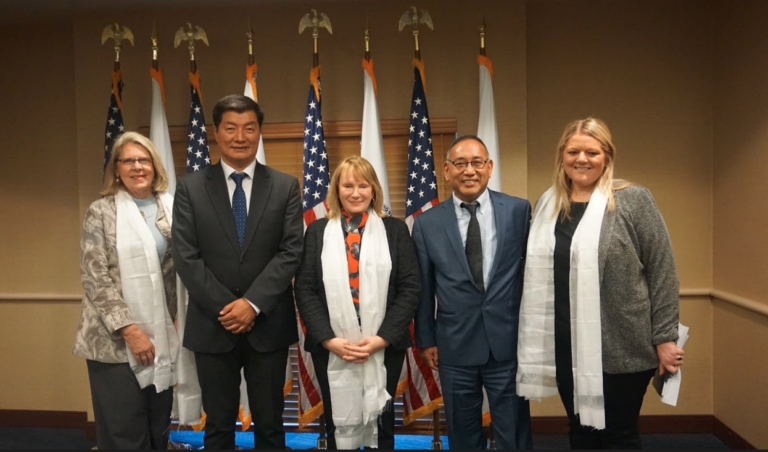Washington DC — During his three-day visit to the capital city, President Dr. Lobsang Sangay met with many high-level United States’ administration officials. On the first day, he met with Samuel Brownback, Ambassador at Large for International Religious Freedom (IRF).
The IRF’s mission is to promote religious freedom as a core objective of U.S. foreign policy. Ambassador Brownback is one of the most effective and passionate voices calling for an immediate stop to religious persecution around the world.
President Dr Sangay and Ambassador Brownback discussed many issues pertaining to lack of religious freedom in Tibet. The Ambassador has met with representatives of the Office of Tibet multiple times since assuming the Ambassador role in February 2018 and is committed to protecting the rights of Tibetan Buddhists to practice their faith freely.
Dr Sangay who is leader of a secular, democratically elected administrative head of the Tibetan government-in-exile, officially known as the Central Tibetan Administration also met with Ivan Kanapathy, Director for China, Taiwan, and Mongolia, National Security Council (NSC) and Laura Stone, Deputy Assistant Secretary of State, Bureau of East Asian and Pacific Affairs.
Additionally, he met with Tom Vajda, Acting Deputy Assistant Secretary for Security and Transnational Affairs, Bureau of South and Central Asian Affairs, and David Ranz, Acting Deputy Assistant Secretary, Bureau South and Central Asian Affairs.
According to the Office of Tibet in Washington, DC., Dr Sangay raised strong concerns about China acting with impunity around the world and specifically in Tibet by enacting increasingly more restrictive policies in Tibetan areas. Many specific and urgent political issues facing the Tibetan people were also discussed.
To express gratitude for the funds provided and to advocate for continued assistance, Dr Sangay met with representatives of three additional bureaus of the State Department: Democracy, Human Rights, and Labor (DRL), Population, Refugees, and Migration (PRM), and U.S. Agency for International Development (USAID).
DRL leads the U.S. efforts to promote democracy, protect human rights and international religious freedom, and advance labor rights around the world. PRM provides aid and sustainable solutions for victims of conflict and stateless people globally and USAID leads international development efforts to reduce poverty and help people become self-reliant.
The official media of the CTA said that Tibetan President met with many Congressional members, staffers, think tank representatives, and gave interviews and a public talk in D.C. He advocated passionately for the United States to stand by His Holiness the Dalai Lama and the people of Tibet.
China claims Tibet has been part of its territory, but Tibetans say their country is an independent nation for centuries. Then the Communist regime began their invasion of Tibet in 1949, reaching complete occupation of the country in 1959. Since that time, more than 1.2 million people, 20% of the nation's population of six million, have died as a direct result of China's invasion and occupation.
In addition, over 99% of Tibet's six thousand religious monasteries, temples, and shrines, have been looted or decimated resulting in the destruction of hundreds of thousands of sacred Buddhist scriptures. Then the Chinese government imposed undeclared martial law in occupied Tibet while continuing its policies of political repression, cultural assimilation, economic marginalization, and environmental destruction.


![Tibet has a rich history as a sovereign nation until the 1950s when it was invaded by China. [Photo: File]](/images/stories/Pics-2024/March/Tibet-Nation-1940s.jpg#joomlaImage://local-images/stories/Pics-2024/March/Tibet-Nation-1940s.jpg?width=1489&height=878)
















